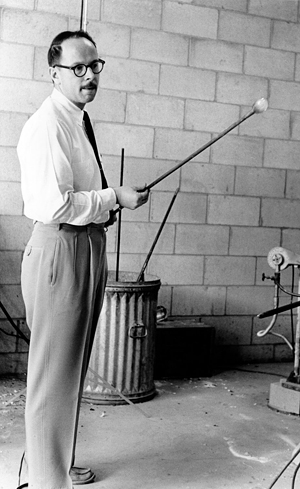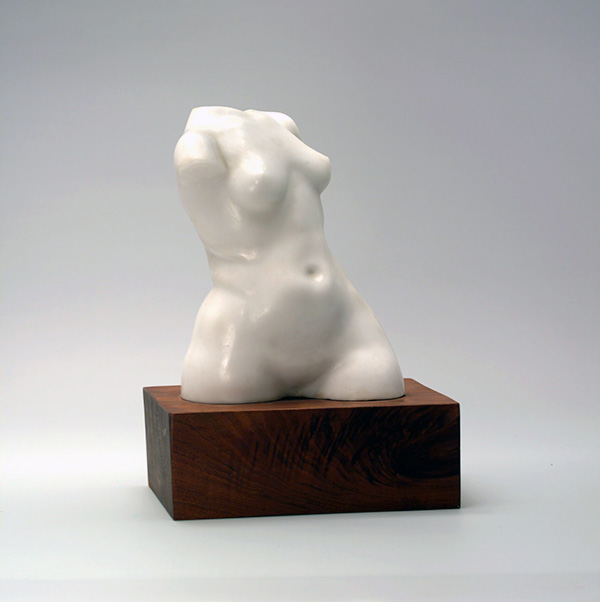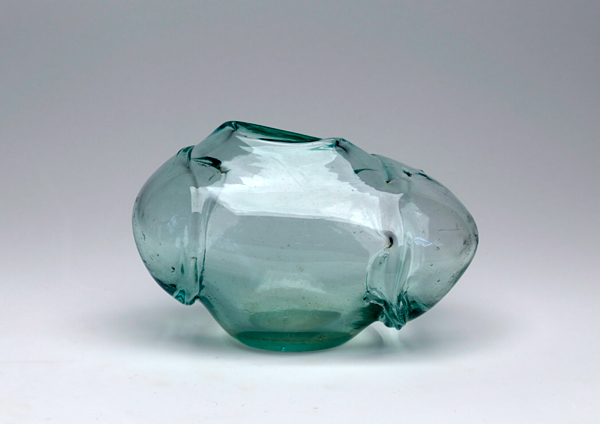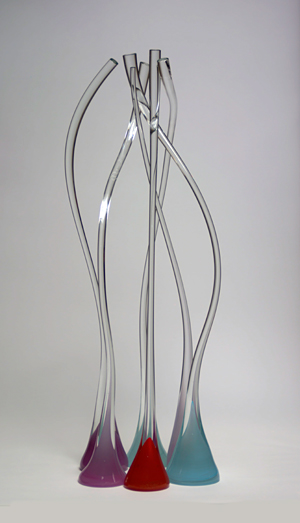A Legacy in Glass:
Celebrating the 50th Anniversary of the American Glass Movement
A Legacy in Glass was on display at Richmond's Visual Art Center from November 9 – January 13.
The following text, by curator Caroline Wright, appeared as six wall panels in the exhibit.
 |
|
| Harvey K. Littleton: First Toledo Workshop 1962 |
Harvey K. Littleton is internationally recognized as the pioneering champion and founding father of the American studio glass movement. In March and June of 1962, after years of research, Littleton led two experimental workshops at the Toledo Museum of Art. There he proved that artists could mix and melt glass in small furnaces and blow glass in individual studios. Prior to these 1962 workshops, glass was solely a factory material used to make functional, utilitarian objects. Littleton’s innovative use of blown glass as a sculptural material revolutionized glassmaking into a viable medium for artistic expression and contemporary art.
A son of the physicist who developed Pyrex for Corning Glass Works, Littleton was born and raised in Corning, New York. He studied physics and industrial design before earning a Master of Fine Arts in ceramics from the Cranbrook Academy of Art. Littleton served on the faculty of the University of Wisconsin–Madison from 1951–1977, initially teaching ceramics before he established the first studio glass curriculum in the United States. Many of Littleton’s first students in the glass program at Wisconsin—Dale Chihuly, Fritz Dreisbach, Sam Herman, Marvin Lipofsky, Tom McGlauchlin, Christopher Ries, and Michael Taylor—became leaders in the studio glass movement, inspiring and educating the next generation of glassmakers across the country and around the world.
Littleton retired from teaching in 1977 and moved to Spruce Pine, North Carolina, where he continues to live today. In Spruce Pine he set up a glass studio and produced the most technically challenging and physically demanding work of his career. He also established Littleton Studios, a printmaking shop dedicated to the vitreographic process of printing on glass plates.
Today, Littleton’s work is in the collections of museums worldwide, including the Metropolitan Museum of Art, the Museum of Modern Art, the Corning Museum of Glass, the Museum of Arts & Design, the Smithsonian American Art Museum, and the Victoria and Albert Museum in London. Presenting work spanning five decades of Littleton’s momentous career, A Legacy in Glass celebrates the fiftieth anniversary of the American studio glass movement and Littleton’s remarkable legacy as one of the leading artistic innovators and visionary educators of the twentieth century.
~
While a college student at the University of Michigan, Littleton returned home to Corning, New York, in the summers of 1941 and 1942 to work at Corning Glass Works. In the Vycor multiform project laboratory, he learned to make molds and cast glass sculpture, a process he revisited when he returned to the Vycor lab after serving the United States Army for three years during World War II. In 1946, Littleton made a mold from a clay female torso he modeled in England and translated it into white Vycor glass. The initial casting was purchased by the Arnot Art Museum in Elmira, New York, an acquisition that foreshadowed Littleton’s forthcoming career.
 |
Torso, 1946 |
Interested in exploring new applications for glass as a material, Littleton submitted a proposal to Corning Glass Works in 1947 for an in-house experimental glass studio that would be open to all divisions of the factory. His proposal was denied, and he turned his artistic interests to becoming a studio potter. After earning his Master of Fine Arts in ceramics at the Cranbrook Academy of Art, Littleton joined the faculty of the University of Wisconsin–Madison in 1951. For the next decade he exhibited his pottery nationally and internationally, but he grew more and more devoted to the idea of working creatively with glass.
Preparing for a research grant trip to Europe in 1957, Littleton asked Steuben Glass Works president Arthur Houghton Jr. if he knew anyone working in a solo glass studio. Houghton referred him to Jean Sala, a Catalonian artist living in Paris. Upon their introduction, Sala, a retired glassblower, mixed a batch of glass and blew it single-handedly at the furnace, confirming Littleton’s steadfast belief that it was possible for artists to work with glass in individual studios. Later, after visiting over sixty small glassworks on the island of Murano, Italy, Littleton purchased enough blowpipes and tools necessary to outfit an individual glass studio on his farm in Wisconsin.
In 1959, Littleton chaired a glass panel at the third national conference of the American Craft Council and spoke about his trip to Europe and his experiments with glass. The following year, he submitted the first of many unfunded applications to the John Simon Guggenheim Memorial Foundation for financial support of his research. Unable to secure funding, Littleton took an unpaid half-time leave from the university to experiment with glass on his farm in Verona, Wisconsin. During this time, he built a furnace inspired by the one used by Jean Sala and created several “yellowish lumps” of glass from a melted batch. He later cut, ground, and polished the glass and carried the small sculptures as illustrations to his presentation “A Potter’s Experience with Glass” at the fourth national conference of the American Craft Council in Seattle, Washington. In his closing statements, Littleton announced that he hoped in 1962–1963 to “take a group of five graduate students in independent study and explore some of the glassworking methods in my own shop within the framework of the graduate program at the University of Wisconsin.”
~
On March 23, 1962, ten people gathered in a storage shed at the Toledo Museum of Art for Littleton’s first weeklong experimental glassblowing workshop. Otto Whitman, director of the museum, provided the long-awaited financial support for the seminar. Attendee Dominick Labino, a local glass research scientist at the Johns Manville Corporation, provided the material knowledge that ultimately led to the success of the event and the historical “birth” of the American studio glass movement.
The students’ first batch of glass, based on an industrial formula, proved too stiff for glassblowing. Upon recognizing flaws in the original furnace design, Labino urged the group to tear apart and rebuild the furnace. Then he successfully melted a bag of #475 Johns Manville marbles into molten glass malleable enough for everyone to blow. These marbles provided the necessary raw material, and the redesigned small furnace provided the crucial piece of equipment, freeing artists to blow glass in independent studios. Littleton used the #475 marbles to produce his own work for the next four years, while his collaboration with Dominick Labino continued until the scientist’s death in 1987.
 |
| Blue-Green Prunted Form, 1963 Glass from #475 marbles Image courtesy of Maurine Littleton Gallery 5 x 8 x 4½ |
In July of 1962—following the second glassblowing workshop at the Toledo Museum of Art—Littleton returned to Europe where he met another lifelong friend and collaborator, kindred spirit and glassmaker Erwin Eisch. Eisch’s free-form, expressive use of blown glass ignited Littleton’s interest in abandoning the functional vessel form for a contemporary, sculptural application of glass. Upon his return to the University of Wisconsin–Madison in the fall of the same year, Littleton established the first studio glass program in the country and urged other universities and art institutions to develop programs as well. He delivered thirty-five lectures within the year promoting hot glass as a viable new material for contemporary art.
Museum recognition for Littleton’s groundbreaking work soon followed. He was granted solo shows at the Art Institute of Chicago in 1963 and the Museum of Contemporary Craft in 1964; in 1965 his work was acquired for the permanent collection of the Museum of Modern Art. By the late 1960s, Littleton began working with a new batch formula (primarily composed of barium and potash). Following Eisch’s example, he began making purely sculptural work informed by the fluidity and transparency of molten glass. Littleton’s newfound exploration of folded tubes, pulled columns, layered color, and implied motion would inspire his creative vision for the remainder of his career. Meanwhile, his first students from the University of Wisconsin–Madison introduced their own creative visions to the world, establishing studio glass departments and independent glass schools across America. Ten years after the first workshops in Toledo, fifty studio glass programs were in place in the United States.
~
In 1976 Littleton retired from teaching and moved from Wisconsin to Spruce Pine, North Carolina, to work on his art full-time. During the late 1970s and early 1980s, he refined his work technically, expanding upon his exploration of the physical qualities of glass by creating larger, more vibrant sculptures that he finished through cold-working processes.
|
| Purple Amber Eye Form, 1980 Barium/potash glass with metallic oxides 5; 3 ½; 2; 1 ¼ |
From 1969 through the mid-1970s, Littleton produced a series of works he called Eye Forms based upon his interest in the refractive properties of glass. He positioned four sets of nested (colored and halved) glass orbs on a glass base. Littleton explained, “The cut surface lets you see into the wall of the hemisphere, and the light is concentrated by the curving sides and reflected back out the cut edge. This gives a rich, deep, intense colored circle of light.” Littleton considered the Eye Forms a catalyst for his later studies on optic qualities and color relationships in glass.
|
|
| Oblique Truncated Form, 1980 Barium/potash glass with multiple cased overlays of Kugler color 12 x 5 x 3 |
|
In his new Spruce Pine studio, Littleton began working with German Kugler color bars that dramatically altered his palette. Able to create subtle color overlays, he embarked on the series that would become his best known; he formed the Solid Geometry series of long, twisted, and bent sculptures using thick tubes of clear glass that encased solid layers of color. Littleton finished most of the works in this series by cold-working—sawing the cooled glass at angles before grinding and polishing. In clarifying his process Littleton stated, “Sliced across, the overlays appear as concentric circles of color suspended in light. The optic properties of the heavy, highly polished glass multiply the views of the forms within.”
During the mid-1970s, Littleton also began exploring the use of glass for printmaking. In 1974 during a university seminar devoted to cold-working glass techniques, Littleton developed a new process for printing on glass plates which he coined vitreography. Using hot glue and a resist, he sandblasted a piece of plate glass and successfully printed the image (now known as Trial II). Vitreography—a relatively non-toxic form of printmaking—uses inexpensive, readily available materials such as windowpane glass, glass etching solutions, and sandblasting tools to create hand-pulled prints from a glass matrix. In 1981 Littleton hired a full-time master printer for Littleton Studios and encouraged glass artists who visited his studio to make vitreograph prints. He continued to make his own prints exploring the optical qualities of light and color in glass until 2001.
|
| 00 Buckshot State III, 2001 Vitreograph, color intaglio print from glass plate with Digital Transfer 17 ¾ x 15 ½ |
~
|
| Blue Conical Intersection with Ruby and Orange Ellipsoid, 1985 Barium/potash glass with multiple cased overlays of Kugler color Collection of Colleen and John Kotelly |
In 1983, in recognition for his “consummate craftsmanship,” Littleton became the third person to receive a Gold Medal from the American Craft Council. This award acknowledged both his technical skill and his tireless investigations of the physical properties of glass. Ever eager to experiment, Littleton continued to embark on ambitious projects in the 1980s, including a series of Conical Intersections where he forcibly combined two separate glass forms by driving a cooler, hardened cone-shaped piece into a hotter, softer ovoid piece. The adjoined forms presented the drama of their making, exposing veiled and distorted layers of colored overlays. Concurrently, Littleton also created dynamic, kinetic works in his Mobile Arc series, balancing U-shaped forms designed to rock back and forth for extended periods of time.
 |
|
| Opal/White/Orchid Lyrical Movement, 1988 Soda/lime glass with multiple cased overlays of Kugler color |
|
Plagued by back problems, Littleton abandoned making heavy sculptures in the late 1980s. His last two series, Implied Movement and Lyrical Movement, comprised of long, tendril-like cased forms that were lighter and easier to manipulate but still allowed the action-reaction interplay of working with hot glass. These organic sculptures, frozen in motion to the pull of gravity and to the pull of the artist, enabled Littleton to work with space and delicate compositional relationships. “The ones with only two pieces were the hardest to work out,” he noted. “Three was easy, but a composition of two was really difficult.”
Despite his retirement from the hot glass studio in 1990, Littleton continued his commitment to improving the applications and materials for studio glass. In 1986 he commissioned Dominick Labino to create a durable and affordable clear glass batch formula that would melt easily in studio furnaces. Soon thereafter, he purchased an old drive-in movie theater near Spruce Pine where he built a small plant to manufacture Spruce Pine Batch, now used widely in the glassblowing community by individuals and by schools including Penland School of Crafts and Pilchuck Glass School.
In the mid-1980s Littleton also expanded his printmaking facility to accommodate additional presses and the growing collection of vitreograph prints by visiting glass artists including Erwin Eisch, Italo Scanga, and Ann Wolff. Maintaining glass as his subject matter, Littleton continued to investigate properties of light, prismatic color, and form (including the visual qualities of broken glass) through his own vitreographs.
An impassioned educator and advocate for possibilities and progress in studio glass, Harvey Littleton continued to collaborate with other artists until recent years. Today his proselytizing, visionary spirit has inspired and influenced multiple generations of studio glass artists. Referencing his own historical contributions, Littleton said, at the glass symposium in Frauenau, Germany, in 1988:
Caroline Wright is the Director of Exhibition Programming at the Visual Arts Center of Richmond. As an undergraduate, Wright worked on the exhibition Harvey K. Littleton: Reflections, 1946–1994 at the Mint Museum of Craft + Design in Charlotte, NC.History is the artist’s profession, too. If we don’t work, there is no history of art.
History to me is not a static absolute but a continuum, a dynamic. We artists rewrite
history as we go along. . . . The burden of history is ours, not the historians! The
future is WORK.
A Legacy in Glass
Founders of American Studio Glass ![]()
Acknowledgements